CHARBRAY EDITORIALS - 2010
Atherton State High School - December 2010
ATHERTON STUDENTS SPREAD CHARBRAY MESSAGE - DECEMBER 2010
A group of dedicated high school students are helping to educate northern beef producers about the benefits of breeding Charbray cattle through a school stud cattle program.
The show team from the Atherton State High School has been on the local show circuit for the past two years, notching up some impressive wins and gaining the respect of local breeders.
Mandy Lindsay is the head of the Agricultural Department at the Atherton State High School and has been instrumental in getting the School’s Charbray Stud off the ground.
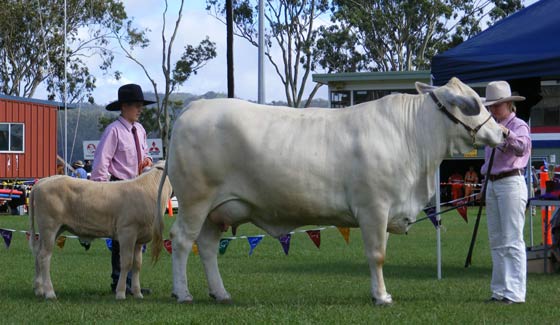
Ms Lindsay said the Agricultural Department decided to start breeding stud animals in 2007 and now has a herd of seven registered Charbray breeders and four calves.
She said the school chose to breed Charbray cattle for their tick resistance and size.
“Most of the beef producers up here have Droughtmaster or Brahman herds and we wanted something a bit different that still had that Bos Indicus content,” she said.
“We also wanted something with a bit of size and that’s why we chose Charbrays.”
“We get a lot of comments from locals when we are exhibiting cattle about the size of our cows and calves.”
Mr Lindsay said the school sold off their commercial herd in 2007 and purchased two purebred Charbray cows.
After registering those cows, the school then moved to purchase two more purebred cows from local breeders.
She said the school students do all their own insemination work, using semen from Greenfields Big Al, Dallas Rancho Apollo, Colinta Savoy and a Charolais bull, Palgrove Magnum.
“We are really aiming to breed offspring that are 50% Charolais and 50% Brahman but we initially had to use a Charolais bull because some of our cows had a higher Brahman content than we would have liked,” she said.
“Now we are only using registered Charbray bulls.”
Ms Lindsay said the school is also aiming to breed only polled animals.
“Health and safety is obviously a big issue for us at the school but I think more and more breeders are looking for polled animals anyway.”
“The School also has very high animal welfare regulations so dehorning is also a real issue for us on that level.”
Around 220 students are currently studying agriculture at the Atherton State High School which has a total enrollment of 875 students.
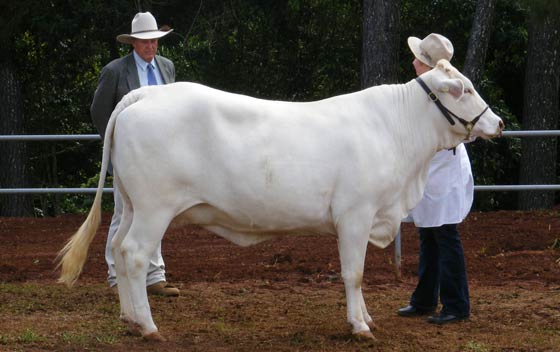
Ten students are currently members of the show team and regularly give up their lunch breaks, weekends and afternoons to care for the stud animals.
They performed extremely well on the local show circuit this year, taking home a swag of awards including Grand Champion Female at the Malanda Show, Grand Champion Female at the Atherton Show and Grand Champion Female at the Tully Show. The show team also secured multiple awards in junior handler competitions. Ms Lindsay said participating in the show team is beneficial for the students on a number of levels.
“When they are showing cattle they learn how to interact with other people and it helps them gain confidence and self esteem,” she said.
“It also exposes them to different breeds of cattle and they get to compare those breeds.”
“They also get to hear the comments of the judges which helps them to understand more about the beef industry as a whole.”
“It’s a wonderful program and one that the kids are really excited to be involved in.”
Charbray National Sale - October 2010
AN ALL CHARBRAY AFFAIR IN ROCKY - SEPTEMBER 2010
By QCL
THE Charbray National Sale was held in Rockhampton last week, with a meet and greet held at the Sun Palms restaurant kicking off the action on Tuesday evening.
A good crowd of vendors, buyers and families was on hand to witness presentations in recognition of service to the breed. A wine auction followed, with people showing plenty of interest.
The most popular presentation on the night was a life membership awarded to long-time stalwart of the Charbray breed, and an absolute gentleman, Jim Connolly. Jim gracefully accepted the award with a genuine display of emotion, reflecting his dedication and affection for the breed and all involved. Jim backed up as auctioneer, offering various items in a fundraising bid for the Billboard Fund.
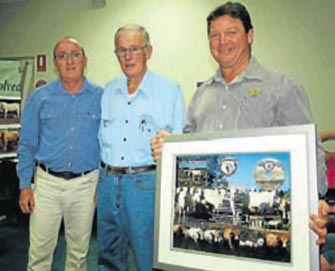
Warren Smith, Mothar Mountain, Charbray Society treasurer, and president Matt Welsh,award life membership to a deserving gentleman and breed stalwart, Jim Connolly, Gympie
And though some rather ‘social’ Charbray supporters were feeling a little dusty the following morning, the show continued, with a well attended sale on Wednesday. 77 bulls were offered by 20 vendors, grossing $231,500, for an average of $3991, to a top of $8500, with one bull passed in at $10,000.
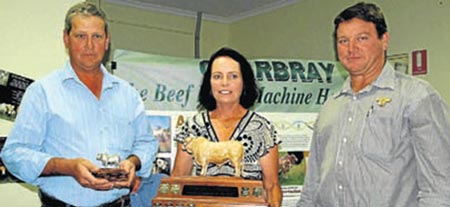
Rob and Denise Newcombe, Newcombe Charbrays, receive the prestigious Tartrus award from Matt Welsh for the promotion of the breed through their exceptional 2010 Show Team.
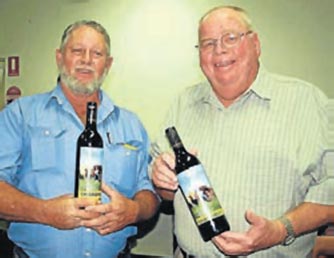
Ken Rutherford and Brian Nichols, two long-serving Charbray
Society councillors retiring after many years of service, were
recognised for their combined achievements for the Charbray Breed.
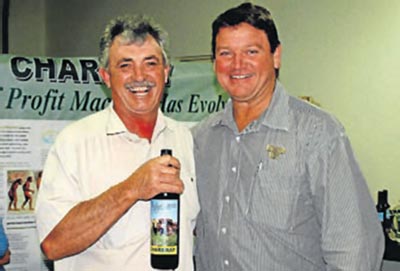
Les Marshall Greenfields, Jambin, receives his Vintage 2010 Charbray bottle,
from Charbray Society president Matt Welsh, for his outstanding efforts in attracting new
commercial members.
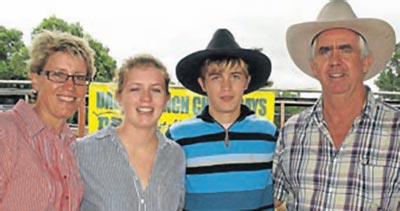
The Cox family, from Glensfield Station, Nebo – Rosalie and John with
Sarah and Clancy, inspecting the bulls on offer at the Charbray National Sale
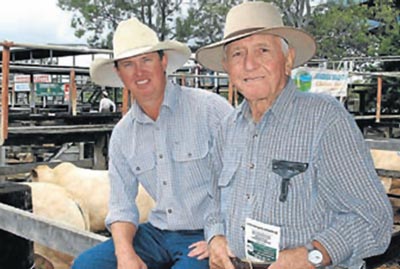
Eric Nobbs, Lyndhurst, Calliope, with Phillip Nobbs, Cordelia, Moura.
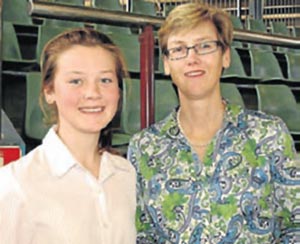
Rachael and Meg Welsh, Huntington Charbrays,Taroom,
watching the selling action at the 2010 National Charbray Sale.
Charbray National Sale - October 2010
SURGE IN CHARBRAY ENQUIRY AS NATIONAL SALE LOOMS
By Penelope Arthur
A surge in enquiry regarding the National Charbray Bull and Female Sale at Rockhampton in late September is providing some positive encouragement as the vendors put the final touches on their selections.
Ninety registered bulls, two herd bulls and forty females will be offered at the sale on Wednesday September 22 starting at 10am.
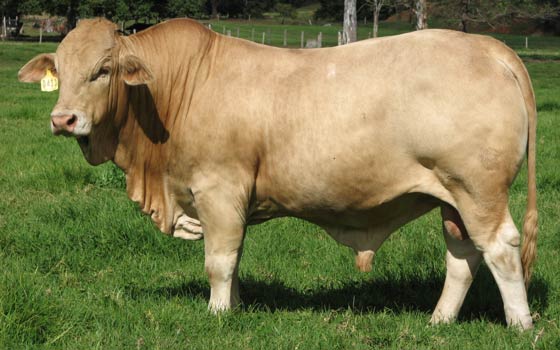
Charbray Society President Matt Welsh said he has noticed a lift in enquiries for Charbray bulls this year, particularly from buyers in areas such as the southern states and the Top End of Australia. He said the unfortunate restrictions on live exports out of northern Australia are forcing some producers to look at more versatile breeding options such as Charbrays.
“Producers in western and northern Australia are being forced to look to eastern markets and some are now looking for that Charbray influence because it is well suited to both markets,” he said.
“You see it in Roma every week – if you turn up with a pen of Charbray cattle they attract the attention of the buyers.”
“We’ve had some new enquiry from the southern States and it’s very encouraging to see that recognition of the breed is moving further south.”
Mr Welsh is hopeful a return to good seasons across much of Queensland will also bode well for the 33rd National Charbray Sale.
“Hopefully the return to better seasons signals a return to the good old days of cattle production and with that, a reemergence of what we believe is the Australian beef industry icon – grassfed beef,” he said.
“That’s where I believe the Charbray breed is second to none – with extra growth rates and doing ability our cattle are the perfect fit for that market.”
Twenty vendors will line-up at this year’s sale where the standard of bulls is expected to be higher than ever. All Bulls will be subject to a full veterinary examination including semen testing prior to the sale. Measurable objective data including fat scans, EMA scores, scrotal measurements and weights will be collected at Gracemere Saleyards on the day prior to the sale and will be available on the supplementary sheet.
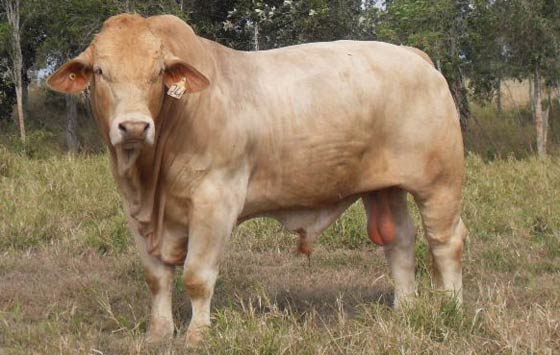
Buyers interested in viewing lots prior to the sale are invited to inspect the stock on the eve of the sale at the Gracemere Saleyards and to join the Charbray Society for a Meet and Greet Happy Hour Social Function from 6.30pm to 8.30pm at the Sun Palms Motel Function room on Gladstone Road Rockhampton afterwards.
Third time vendors Chas and Judy Nobbs will be offering six registered bulls from their Moura based Cordelia Charbray Stud and say they are looking forward to catching up with new and existing clients at the sale.
“It’s always been a good, solid sale for us and it’s a great opportunity for us to offer our bulls to buyers from a wider market,” he said.
The 2010 sale will be preceded by the inaugural Charbray 2010 Commercial Female Show and Sale which will kick off at 9am.
Charbray Society vice president Paul Connor said this new initiative would provide a valuable opportunity for Charbray breeders to showcase their females to buyers and create a true “breed spectacle”.
“From the interest that has been shown in this event from both vendors and buyers we definitely expect the Female Show and Sale to feature a quality line-up,” he said.
“There is certainly very strong demand for good Charbray females and we’d really like to make this an annual event and would not rule out including males in the concept.”
Sale Catalogues are available on the Charbray Society website at www.charbray.org or by contacting the office on 1300 242 727 or email admin@charbray.org
Charbray Bull Credits - August 2010
$7500 IN CHARBRAY BULL CREDITS UP FOR GRABS
By Penelope Arthur
CATTLEMEN planning to head to the National Charbray Bull and Female Sale in Rockhampton on September 22 now have an opportunity to score $2500 worth of bull credits before they even step into the Gracemere sale arena. The Charbray Society of Australia has teamed up with the Queensland Country Life to offer three lucky readers bull credits valued at $2500 each to spend at the National Sale.
Charbray Society President Matt Welsh said the joint promotion, worth $7500, is expected to attract plenty of attention from Charbray breeders around the State. Mr Welsh said buyers at the National Charbray Bull and Female enjoyed the security of knowing they were buying from registered Charbray seedstock producers.

Charbray Society President Matt Welsh
“We’d really like to encourage prospective Charbray breeders to not just study the bulls they are buying but to also take a serious look at the seedstock producer and the breeding program behind the bulls,” he said.
“It makes a lot of sense to buy bulls from a registered and recognised Charbray breeder and everyone can do that with confidence at the National Sale.”
“We are also really excited to be teaming up with another major player in the beef industry in the Queensland Country Life to run this promotion.”
Mr Welsh said registered Charbray seedstock producers invested a great deal of time and effort on breeding programs that aim to produce bulls and females to deliver long term gains to any herd.
“Real Charbray breeders are not just looking to take advantage of that initial hybrid vigor by marketing impressive looking progeny as a throw away product, predominantly for cash flow gain,” he said.
“A real Charbray breeder is prepared to take their initial progeny into a measured and calculated breeding program and build consistency of product and real viability.”
“In doing this we also have one very real advantage over other breeds and that is that the parent breeds of Charbray stand at the top of the class in their respective Bos Indicus and Bos Taurus breed groups.”
104 bulls and 42 females will go under the hammer at the National Charbray Bull and Female Sale on Wednesday September 22.

Charbray National Sale Lot 71
Mr Welsh said the sale was already attracting strong interest from prospective buyers keen to capitalise on the marketability of Charbrays.
“We have seen some encouraging growth in the level of enquiry for the sale and that’s largely been driven by producers who are looking for greater flexibility in their marketing,” he said.
“We have seen some changes in the live export market recently and a lot of producers who have traditionally targeted that market are looking to the Charbray breed to help them produce a product that suits a variety of markets.”
Charbray 2010 Commercial Female Show & Sale - April 2010
CHARBRAY 2010 COMMERCIAL FEMALE SHOW & SALE
By Penelope Arthur
The introduction of a Commercial Female Show and Store Sale to the 2010 National Charbray Bull and Female Sale at Gracemere in September will add an exciting dimension to the annual event.
Charbray Society of Australia President Matt Welsh said the decision to include a Female Show and Sale comes after a high level of interest in Charbray females from breeders across eastern Australia.
Mr Welsh said the Female Show and Sale would provide a valuable opportunity for breeders to showcase their females in what is expected to be a premium marketplace.
“There are many very good quality lines of Charbray females out in there and this is an opportunity to showcase a number of them and hopefully earn a premium for the breeders,” he said.
“We would recommend to all those people that marvel over what good Charbray females they have to bring them along and help us put the Charbray breed on show.”
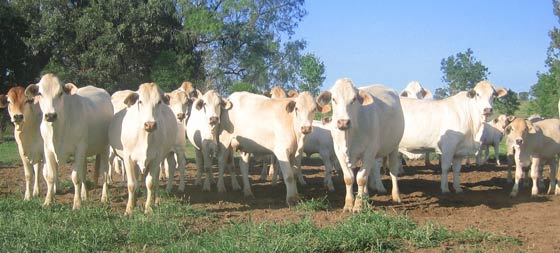
Entries are open to all commercial Charbray breeders and vendors can enter a minimum of ten head in each pen.
Mr Welsh hopes the concept will become an annual event as part of the National Sale which will be held at the Gracemere Saleyards on Wednesday September 22.
“This is just a new dimension to the National Sale which is gearing up to be a big event again this year,” he said.
“Everyone has a much more enthusiastic outlook on the industry this year following the awesome wet season.”
The Charbray Society of Australia is also hoping those heading to Rockhampton will spot a new billboard promoting the Charbray breed on their entry into the city.
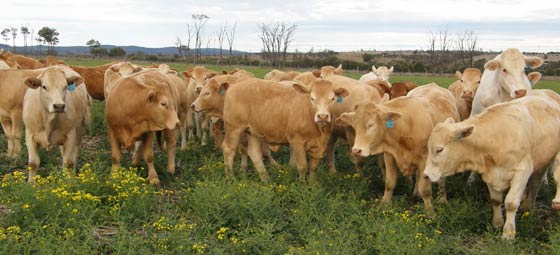
Mr Welsh said billboard was created with the input of members and had been designed to draw attention to the Charbray breed.
“The Charbray breed will always promote itself through performance in the paddock and the marketplace so the billboard is simply there to try and grab peoples attention as they drive past,” he said.
For more enquires on the Female Show and Sale or the National Charbray Bull and Female Sale please contact the Charbray Office on (07) 49 250 510.
Entry Fee: $25.00 Per Pen
Prizes:
Champion: Trophy & $1000 2010National Sale Credit
Reserve Champion: Trophy & $500 2010 National Sale Credit
Charbray Demand - April 2010
CHARBRAY DEMAND STILL HIGH AT FEEDLOTS
By Penelope Arthur
CHABRAY genetics are providing northern cattlemen with valuable marketing options as Charbray cattle continue to prove their place in both southern slaughter markets and the live export market. An increasing number of producers across northern Australia are opting to use Charbray genetics to ensure the progeny will hit both markets.
The list of producers now using Charbray’s in the north includes some big names with S Kidman and Co and the Consolidated Pastoral Company both introducing Charbray genetics over the past decade.
Northern Territory Livestock Exporters Association CEO, Adam Hill, said the trend towards Charbray genetics is also flowing on to smaller, family run operations in the north.
“That bloodline is being targeted for its ability to hit both markets,” he said.
“If things go bad down south then producers can still sell their progeny well through the live export system.”
Greg Pankhurst heads up two Indonesian Feedlots jointly owned by the Consolidated Pastoral Company (CPC) and Jaya Juana Abdi Alam. The venture fed over 80,000 head of cattle in 2009, mainly for Indonesia’s traditional market where beef is used for meals such as curries and meatballs. Around 60% of the intake comes direct from CPC properties in the Northern Territory while the remaining 40% is sourced through the live export market out of Townsville, Darwin and Wyndham.
Mr Pankhurst said there has been a shortage of Charbray cattle coming through the live export system in the past two years as Australian producers opt to take advantage of premiums being paid for flat back cattle in the south.
“We only saw a sprinkling of Charbray cattle come through last year but if we could get some more we would certainly take them,” he said.
“They feed very well, yield very well and the buyers like them.”
Mr Pankhurst said the Indonesian feedlot sector has gone through a strong period of expansion over the past two years.
He said his own operation has expanded capacity by 12,000 head in the past four months while other established competitors have also increased capacity.
“This year Indonesia hopes to take a million cattle (last year they imported 780,000 head) and with that increased demand we hope to see more Charbray types coming into the system,” he said.
“The market is very strong but weather we see more Charbray cattle coming in will depend on what the market does in the south.”
“Charbray’s definitely give producers a good option and it’s an option that will continue to be there.”
Charbray Popularity - April 2010
CHARBRAY POPULARITY HIGH AT SELLING CENTRES
by Penelope Arthur
With the season broken and cattlemen scrambling to restock, the popularity of commercial Charbray cattle at selling centers across Queensland has never been more apparent.
Tony Thorn sources a large number of steers through the Roma Saleyards for his Wandoan based Warrigal Hills Feedlot and says he specifically seeks Charbray cattle for their ability to perform well in the feedlot. Mr Thorn has been operating his 500 head feedlot for seven years and aims to buy steers in at around 300kg and background them on grass at Wandoan before inducting them into the feedlot for 100 days.
He said Charbray’s are the ideal animal for lotfeeding in central and southern Queensland.
“We need a bit of the Brahman factor to give them the heat resistance and the Charolais factor gives them muscling and growth rate,” he said.
“Put them both together and you have a fairly ideal animal for this environment.”
“The Charbray’s also seem to give me ideal fat cover – they don’t often get over fat and we don’t have any trouble putting the fat on them.”
Just down the road, Jeff and Jackie Dann are also on the lookout for Charbray cattle. They finish steers on grass and oats for the Jap Ox market and aim to buy their steers in at 200-300kg. Mr Dann said he specifically looks for Charbray cross cattle when sourcing stock from centers such as Roma, Dalby and Kingaroy.
“You get your growth and weight for age and that’s what it is all about,” he said.
“We get paid for weight so we need to get on as much as possible in as little time as possible while still meeting the grading requirements.”
Further west, Mitchell grazier Tom Hartley has been using Charolais bulls over his Brahman herd for the past 12 years. The Hartley family own five properties north of Mitchell and a further two properties at Barcaldine and Aramac over which they are currently running around 17,000 head of Brahman cross cattle. The progeny are finished for the Jap Ox market and sold exclusively through weekly Roma Prime Sales.
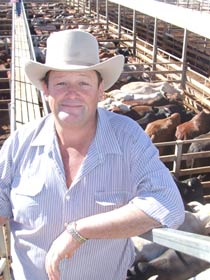
Tom Hartley, Coopermurra, Mitchell sells his Charbray progeny exclusively through the Roma Saleyards and says he has always received favorable feedback from buyers.
Mr Hartley said he has received solid feedback from buyers regarding his Charbray progeny.
“The big advantage of the Charbray’s is the weight in them and that’s what puts them ahead,” he said.
“We have encountered no trouble from buyers receiving them and have always received favorable feedback.”
Saxby Downs - February 2010
CHARBRAY’S THRIVE AT SAXBY DOWNS
By Martin Bunyard
Acquiring one of Queensland’s largest Charbray herds, as part of a property purchase, has proven to be a steep learning curve for the McClymont family.
Just 18 months ago, Alistair McClymont and his family (AJM Pastoral) bought the iconic north-west Queensland property, Saxby Downs, situated north of Julia Creek. With the property came 5000 head of Charbray breeders all with calves at foot. At first Mr McClymont was “surprised Charbrays would have been the type of cattle for a property in the north-west region”, but after 18 months of running the new enterprise the Charbray cattle have proven to be a perfect choice for the type of country on Saxby Downs. The region is a mixture of frontage, downs and forest country.
“We have used Charbrays in a cross breeding programs on our other properties, but didn’t expect them to perform as well as they have up here,” Mr McClymont said.
The McClymont family owns another eight properties in which they run a number of different breeds, one that includes the use of Charbray bulls in a composite breeding program.
“We’ve been breeding Brahman cattle for over 40 years and been using Charbray cattle in our composite breeding program for over 10 years,” he said.
“Up until we acquired the Charbray herd, as part of the purchase of Saxby Downs, we wouldn’t have thought Charbrays could have handled the country in this region so well!
“But, after 18 months of running the property we’ve found they are thriving in this region.”
One of the best traits exhibited by our Charbray breeder herd at Saxby Downs has been their ongoing fertility in all different types of seasonal conditions.
“We are yet to sell any Charbray bullocks from Saxby Downs, but the current progeny is looking very promising.”
The purpose of AJM Pastoral buying Saxby Downs was to expand their business operations and they also plan to continue with the Charbrays herd acquired from the property purchase.
“We are developing as fast as possible with plans to continue expanding the Saxby Downs Charbray breeding herd by at least 10 percent a year.”
As part of the ongoing research and development in their cattle enterprise, Mr McClymont recently went on a trip to see Asia’s different cattle feeding operations.
“I discovered the Charbray breed has a very good reputation in the Asian region,” he said.
“Certainly with the live cattle export industry expanding rapidly in northern Queensland, we are very comfortable and confident that the Charbray breed will cater extremely well to the needs of the Asian live export market. “
Mr McClymont said the average Asian consumers doesn’t want much fat on their meat and that the Charbray breed characteristics prevent them from getting over fat while being feed grain rations in Asian feedlots. This has become a major advantage for the Charbray breed in Asian markets.
“Many feedlots in Indonesia are rapidly expanding their feeding operations. One feedlot I visited during my trip is doubling its capacity from 20,000 head of cattle to 40,000 head.”
More than 750,000 head of live cattle were exported from Australia to Indonesia last year and cattle market analysts forecast red meat consumption to continue increasing in the region as economic and social conditions improve.
“The Charbray cattle we saw in Indonesian feedlots handled the conditions extremely well, with their slick coats and good adaptability traits, and they continued to grow for as long as needed during the feeding process without becoming over fat.”
Another benefit Mr McClymont added was the strong demand in recent times for Charbray cattle domestically, with many Charbray cattle “commanding a 10 cent premium” in southern Australian saleyard markets.
“I attended several different cattle sales in southern Australia last year and found that the Charbray cattle were getting a 10 cent premium during the sale over other breeds.”
Mr McClymont’s son Rex McClymont manages Saxby Downs where all bulls are working in breeding herds at two-years-old with older bulls over six-years-old culled from the herd.
“It’s almost impossible to use pure bred Charolais bulls on our type of country, but the pure bred Charbray bulls are proving they can handle the country very well.”
The McClymont family’s cattle operation focuses on keeping the heifers that will have a calf on the ground before they are three-year-old. The maiden heifers are always joined and calved out on Saxby Down’s best country. Once they have had their first calf, they are moved to the forest or frontage country.
“All heifers that aren’t in calf at just over two-year-old are culled from the herd. Also, any calves that are weaned out of season aren’t retained.”
All steers either go onto the live export market or are taken to a different property to be fattened into bullocks.
“Saxby Downs is safe breeding country and we can turn-off cattle every year, even during unfavourable seasonal conditions,” Mr McClymont said.
“I believe the economic downturn that we are experiencing will improve towards an economic upturn and I predict a shortage of good breeding cows in the future.”
Click here for 2014 Editorials
Click here for 2013 Editorials
Click here for 2012 Editorials
Click here for 2011 Editorials
Click here for 2010 Editorials
Click here for 2009 Editorials
Click here for 2008 Editorials



